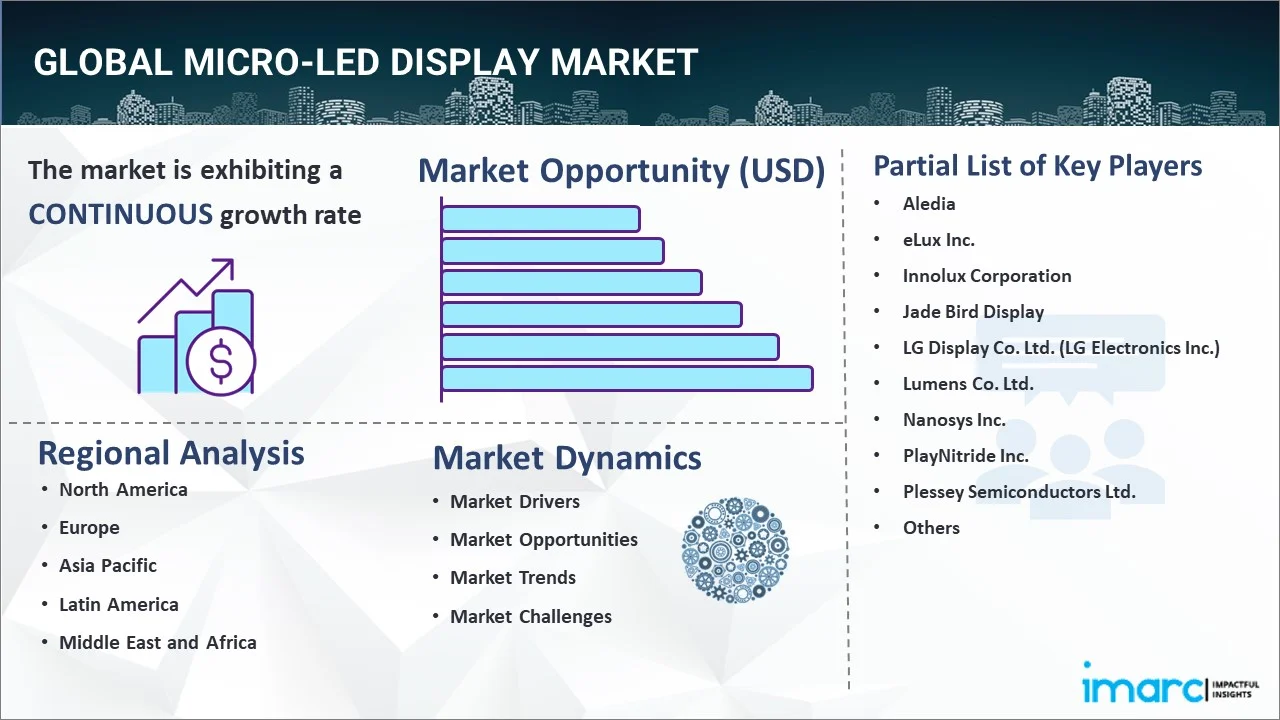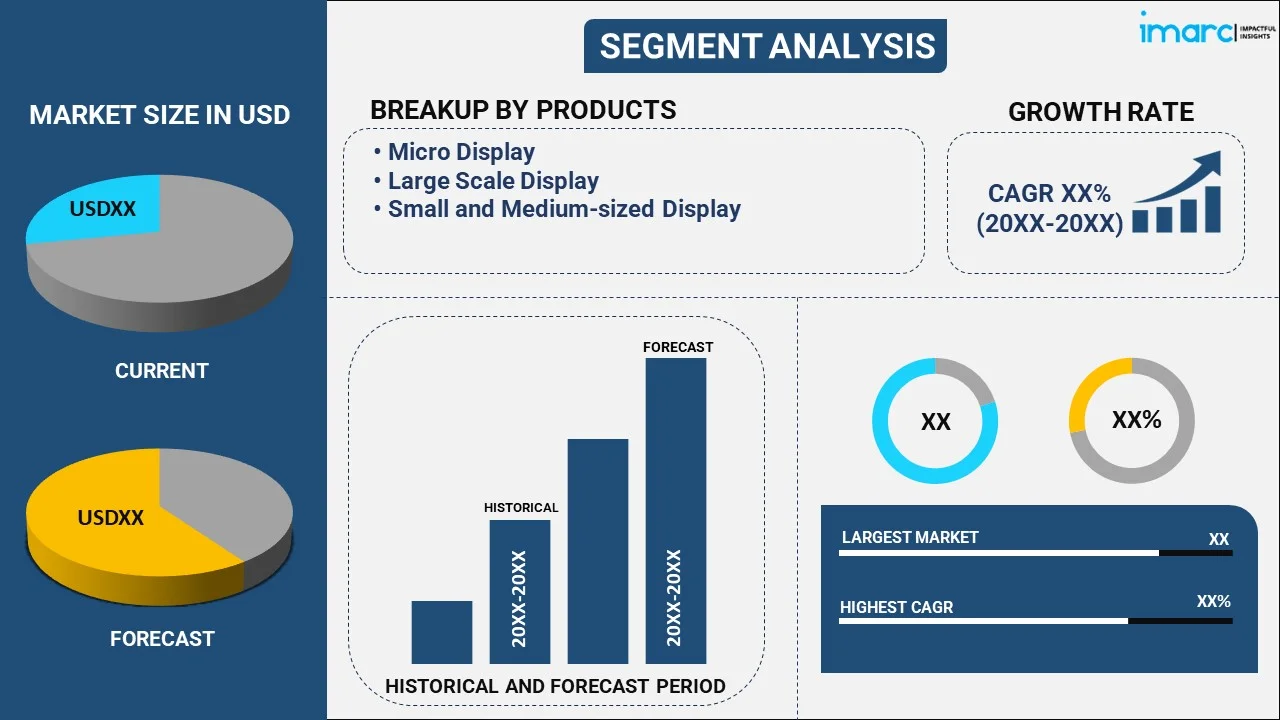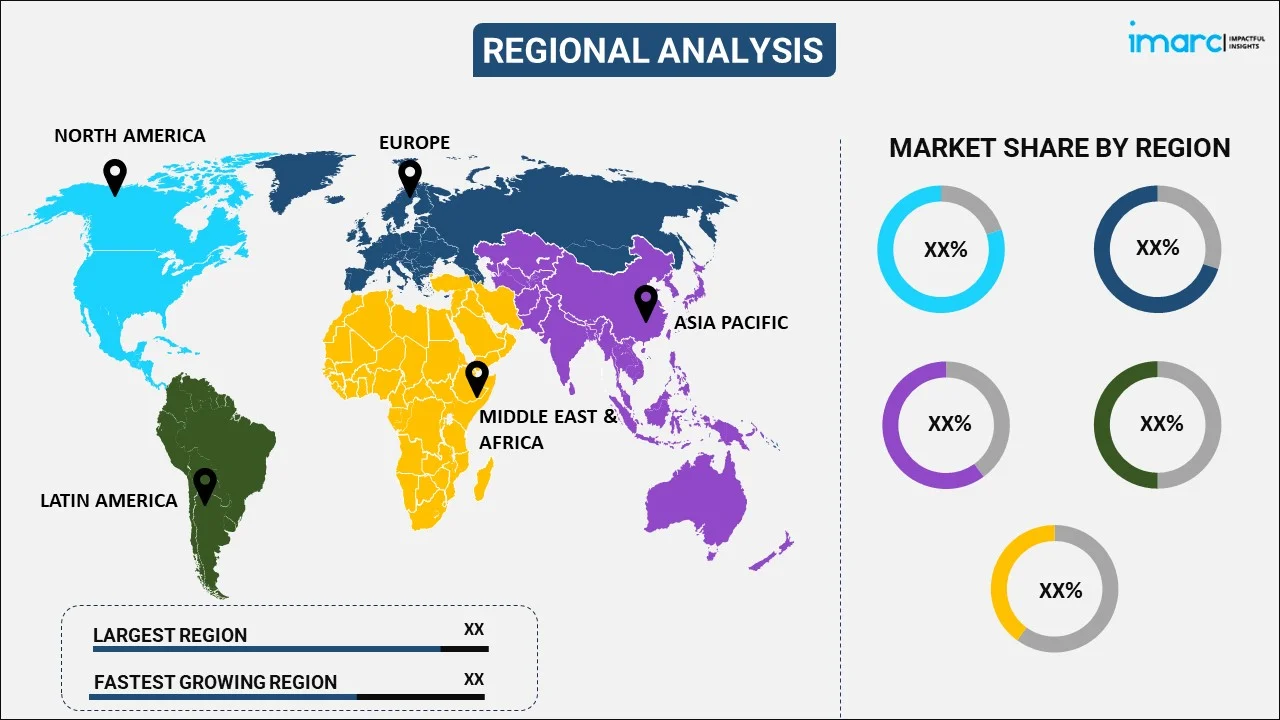
Micro-LED Display Market Report by Product (Micro Display, Large Scale Display, Small and Medium-sized Display), Application (Smartphone and Tablets, PC and Laptop, TV, Smartwatch, and Others), Industry Vertical (Consumer Electronics, Entertainment and Sports, Automotive, Retail, Government and Defense, and Others), and Region 2025-2033
Market Overview:
The global micro-LED display market size reached USD 734.5 Million in 2024. Looking forward, IMARC Group expects the market to reach USD 54,394.7 Million by 2033, exhibiting a growth rate (CAGR) of 58.27% during 2025-2033. The market is driven by the growing awareness among the masses about the advantages of micro-LED display like high brightness and energy efficiency, increasing demand for superior picture quality, and rising focus on scalability.
|
Report Attribute
|
Key Statistics
|
|---|---|
|
Base Year
|
2024
|
|
Forecast Years
|
2025-2033
|
|
Historical Years
|
2019-2024
|
|
Market Size in 2024
|
USD 734.5 Million |
|
Market Forecast in 2033
|
USD 54,394.7 Million |
| Market Growth Rate 2025-2033 | 58.27% |
A micro-light emitting diode (LED) display is a screen with microscopic LEDs of different colors arranged in an array. It is manufactured using gallium nitride, which allows the scattering of red, green, and blue (RGB) LED lights to glow brighter for a prolonged period. It offers high wavelength uniformity, increased brightness, ultra-high definition (UHD) picture quality, and improved color saturation. It also aids in reducing power consumption and offering a longer lifespan and better contrast and response time compared to other conventional technologies. As a result, micro-LED is widely used in smartwatches, micro-projectors, and ultra-high-definition (UHD) televisions (TVs).

Micro-LED Display Market Trends:
High brightness and energy efficiency
Micro-LED displays have higher brightness than regular LCD and OLED panels. This is especially useful for outdoor applications in environments with high ambient light levels, such as stadiums and billboards, where good visibility is essential, which is propelling the micro-LED display market growth. The ability to sustain brightness without significantly reducing image quality makes micro-LED displays excellent for applications that demand consistent performance under varying lighting conditions, hence improving the user experience. Micro-LED technology uses less electricity than traditional display technologies, especially in high-brightness settings. This is accomplished because micro-LEDs emit light directly, without the requirement for backlighting. Lower power consumption results in longer battery life in portable devices and lower operating expenses in large displays, thereby positively influencing the micro-LED display market share.
Superior picture quality
Micro-LED technology opens up a wider color spectrum, allowing displays to generate more brilliant and diverse colors. This capability improves users' visual experiences, especially in apps that require color precision, such as gaming, movies, and photography. Micro-LEDs deliver consistent color performance throughout the display, reducing color shift and guaranteeing that colors are true at all viewing angles, which is offering opportunities for key players. This is essential for professional applications like graphic design and film production. Micro-LED displays attain high contrast ratios by turning individual pixels on and off. This capacity enables for realistic blacks and bright highlights, which improves overall image quality. Such contrast boost enhances the viewing experience, especially for high dynamic range (HDR) video, thereby offering a favorable micro-LED display market outlook.
Scalability
Micro-LED displays are very scalable, which means they may be created in a variety of sizes, ranging from small wearable screens, such as smartwatches to big commercial and public displays. This flexibility enables producers to target a wide range of market areas, including consumer electronics, automotive, retail, and entertainment, which is contributing to the market growth. Micro-LED technology's modular nature allows for the production of custom-sized displays without sacrificing performance or clarity, making it ideal for one-of-a-kind installations such as art displays or large-scale digital signs. Unlike traditional display technologies, micro-LEDs can scale while keeping high pixel density, allowing even big displays to achieve ultra-high definition (UHD) or 8K resolution. This capacity is vital for applications, such as home entertainment systems, professional design tools, and high-end monitors that require precise image clarity.
Key Market Segmentation:
IMARC Group provides the micro-LED display market analysis of the key trends in each ssegment of the global market report, along with forecasts at the global, regional and country levels from 2025-2033. Our report has categorized the market based on product, application and industry vertical.
Breakup by Product:

- Micro Display
- Large Scale Display
- Small and Medium-sized Display
Breakup by Application:
- Smartphone and Tablets
- PC and Laptop
- TV
- Smartwatch
- Others
Breakup by Industry Vertical:
- Consumer Electronics
- Entertainment and Sports
- Automotive
- Retail
- Government and Defense
- Others
Breakup by Region:

- North America
- United States
- Canada
- Asia-Pacific
- China
- Japan
- India
- South Korea
- Australia
- Indonesia
- Others
- Europe
- Germany
- France
- United Kingdom
- Italy
- Spain
- Russia
- Others
- Latin America
- Brazil
- Mexico
- Others
- Middle East and Africa
Competitive Landscape:
The report has also provided a comprehensive analysis of the competitive landscape in the global micro-LED display market. Detailed profiles of all major companies have also been provided. Some of the companies covered include:
- Aledia
- eLux Inc.
- Innolux Corporation
- Jade Bird Display
- LG Display Co. Ltd. (LG Electronics Inc.)
- Lumens Co. Ltd.
- Nanosys Inc.
- PlayNitride Inc.
- Plessey Semiconductors Ltd.
- Samsung Electronics Co. Ltd.
- Sony Group Corporation
- VueReal
Kindly note that this only represents a partial list of companies, and the complete list has been provided in the report.
Micro-LED Display Market News:
- June 2024: Samsung Electronics America announced new additions to its MICRO LED portfolio, including the MS1B (89”, 101” class) and MS1C (114” class screen size) to elevate the home theater experience.
- May 2023: LG Electronics (LG) announced the launch of its new LG MAGNIT (model LBAF) display for virtual production. A huge screen leveraging the company’s cutting-edge Micro LED technology, the new model delivers premium picture quality with deep blacks and vibrant, natural colors, helping directors to create immersive visual experiences.
Report Coverage:
| Report Features | Details |
|---|---|
| Base Year of the Analysis | 2024 |
| Historical Period | 2019-2024 |
| Forecast Period | 2025-2033 |
| Units | Million USD |
| Segment Coverage | Product, Application, Industry Vertical, Region |
| Region Covered | Asia Pacific, Europe, North America, Latin America, Middle East and Africa |
| Countries Covered | United States, Canada, Germany, France, United Kingdom, Italy, Spain, Russia, China, Japan, India, South Korea, Australia, Indonesia, Brazil, Mexico |
| Companies Covered | Aledia, eLux Inc., Innolux Corporation, Jade Bird Display, LG Display Co. Ltd. (LG Electronics Inc.), Lumens Co. Ltd., Nanosys Inc., PlayNitride Inc., Plessey Semiconductors Ltd., Samsung Electronics Co. Ltd., Sony Group Corporation and VueReal. |
| Customization Scope | 10% Free Customization |
| Post-Sale Analyst Support | 10-12 Weeks |
| Delivery Format | PDF and Excel through Email (We can also provide the editable version of the report in PPT/Word format on special request) |
Key Benefits for Stakeholders:
- IMARC’s industry report offers a comprehensive quantitative analysis of various market segments, historical and current market trends, micro-LED display market forecasts, and dynamics of the industry from 2019-2033.
- The micro-LED display research report provides the latest information on the market drivers, challenges, and opportunities in the global market.
- The study maps the leading, as well as the fastest-growing, regional markets. It further enables stakeholders to identify the key country-level markets within each region.
- Porter's five forces analysis assists stakeholders in assessing the impact of new entrants, competitive rivalry, supplier power, buyer power, and the threat of substitution. It helps stakeholders to analyze the level of competition within the micro-LED display industry and its attractiveness.
- The competitive landscape allows stakeholders to understand their competitive environment and provides insight into the current positions of key players in the market.
Key Questions Answered in This Report
The global micro-LED display market was valued at USD 734.5 Million in 2024.
We expect the global micro-LED display market to exhibit a CAGR of 58.27% during 2025-2033.
The rising demand for micro-LEDs in smartwatches, micro-projectors, Ultra-High-Definition (UHD) televisions, etc., as they aid in reducing power consumption and offering a longer lifespan with better contrast and response time, is primarily driving the global micro-LED display market.
The sudden outbreak of the COVID-19 pandemic had led to the implementation of stringent lockdown regulations across several nations, resulting in the temporary closure of numerous end-use industries for micro-LEDs.
Based on the product, the global micro-LED display market can be segmented into micro display, large scale display, and small and medium-sized display. Currently, large scale display holds the majority of the total market share.
Based on the application, the global micro-LED display market has been divided into smartphone and tablets, PC and laptop, TV, smartwatch, and others. Among these, smartphone and tablets currently exhibit a clear dominance in the market.
Based on the industry vertical, the global micro-LED display market can be categorized into consumer electronics, entertainment and sports, automotive, retail, government and defense, and others. Currently, the consumer electronics industry accounts for the majority of the global market share.
On a regional level, the market has been classified into North America, Asia-Pacific, Europe, Latin America, and Middle East and Africa, where Asia-Pacific currently dominates the global market.
Some of the major players in the global micro-LED display market include Aledia, eLux Inc., Innolux Corporation, Jade Bird Display, LG Display Co. Ltd. (LG Electronics Inc.), Lumens Co. Ltd., Nanosys Inc., PlayNitride Inc., Plessey Semiconductors Ltd., Samsung Electronics Co. Ltd., Sony Group Corporation, and VueReal.
Need more help?
- Speak to our experienced analysts for insights on the current market scenarios.
- Include additional segments and countries to customize the report as per your requirement.
- Gain an unparalleled competitive advantage in your domain by understanding how to utilize the report and positively impacting your operations and revenue.
- For further assistance, please connect with our analysts.
 Inquire Before Buying
Inquire Before Buying
 Speak to an Analyst
Speak to an Analyst
 Request Brochure
Request Brochure
 Request Customization
Request Customization




.webp)




.webp)












